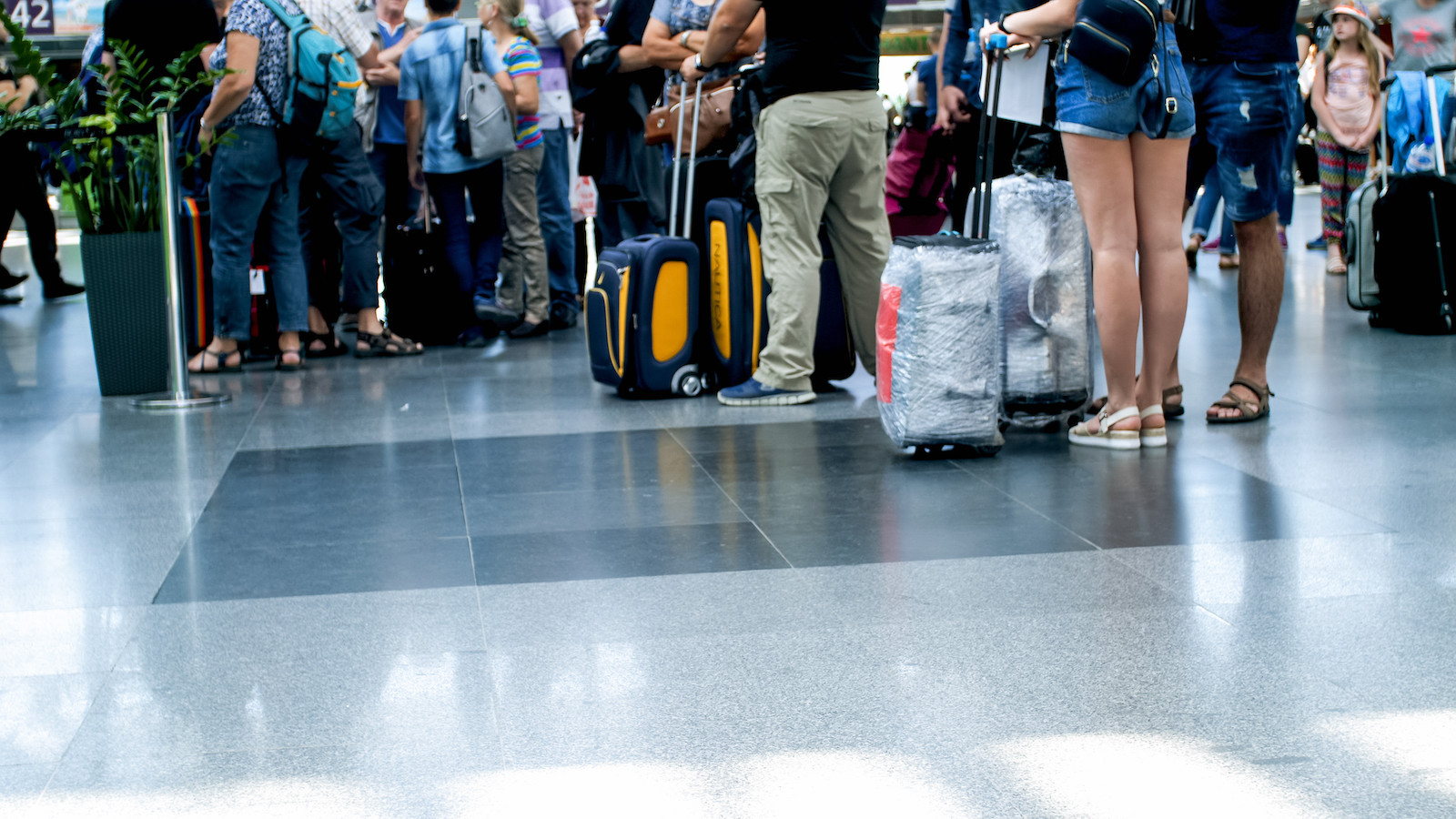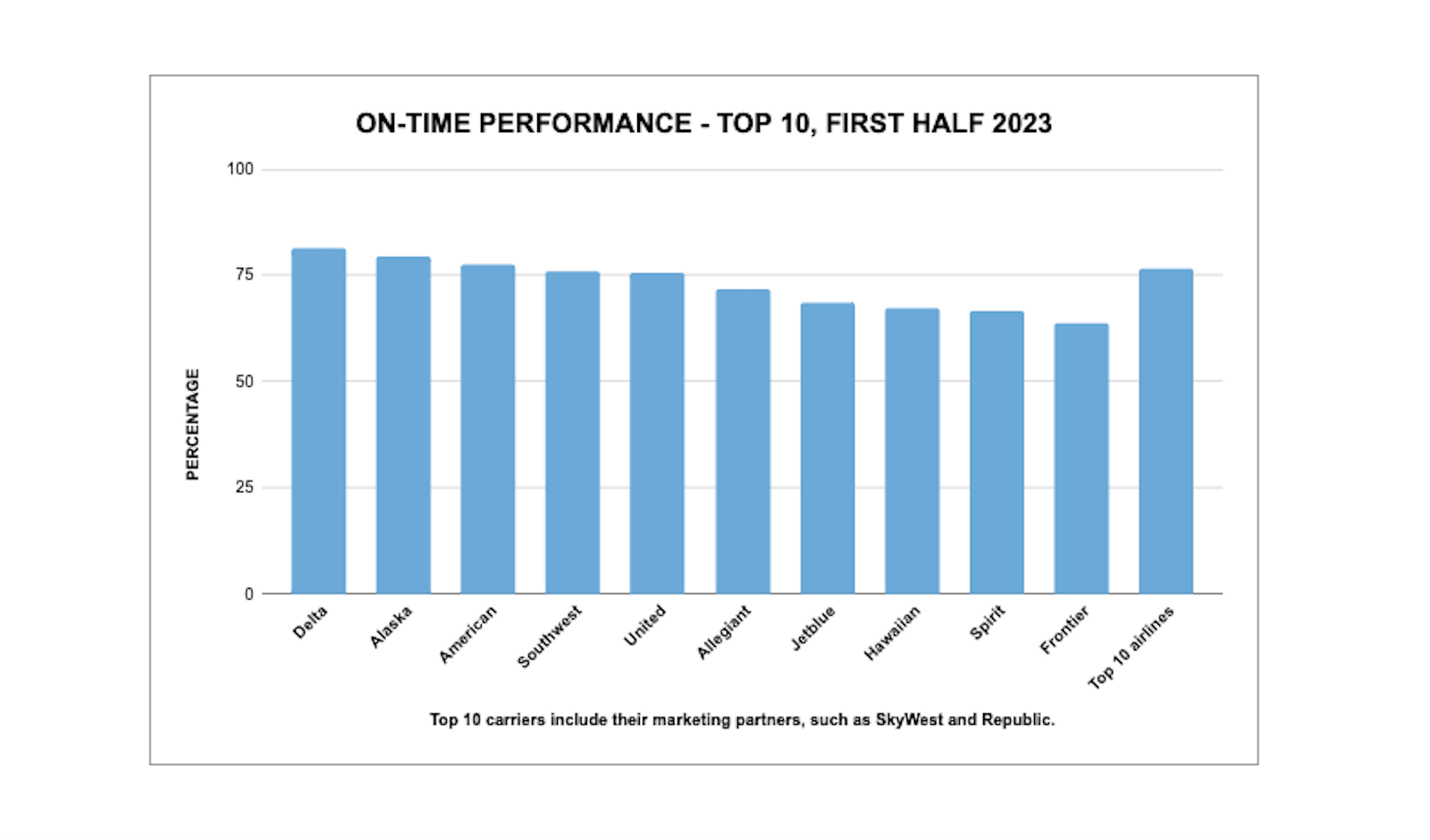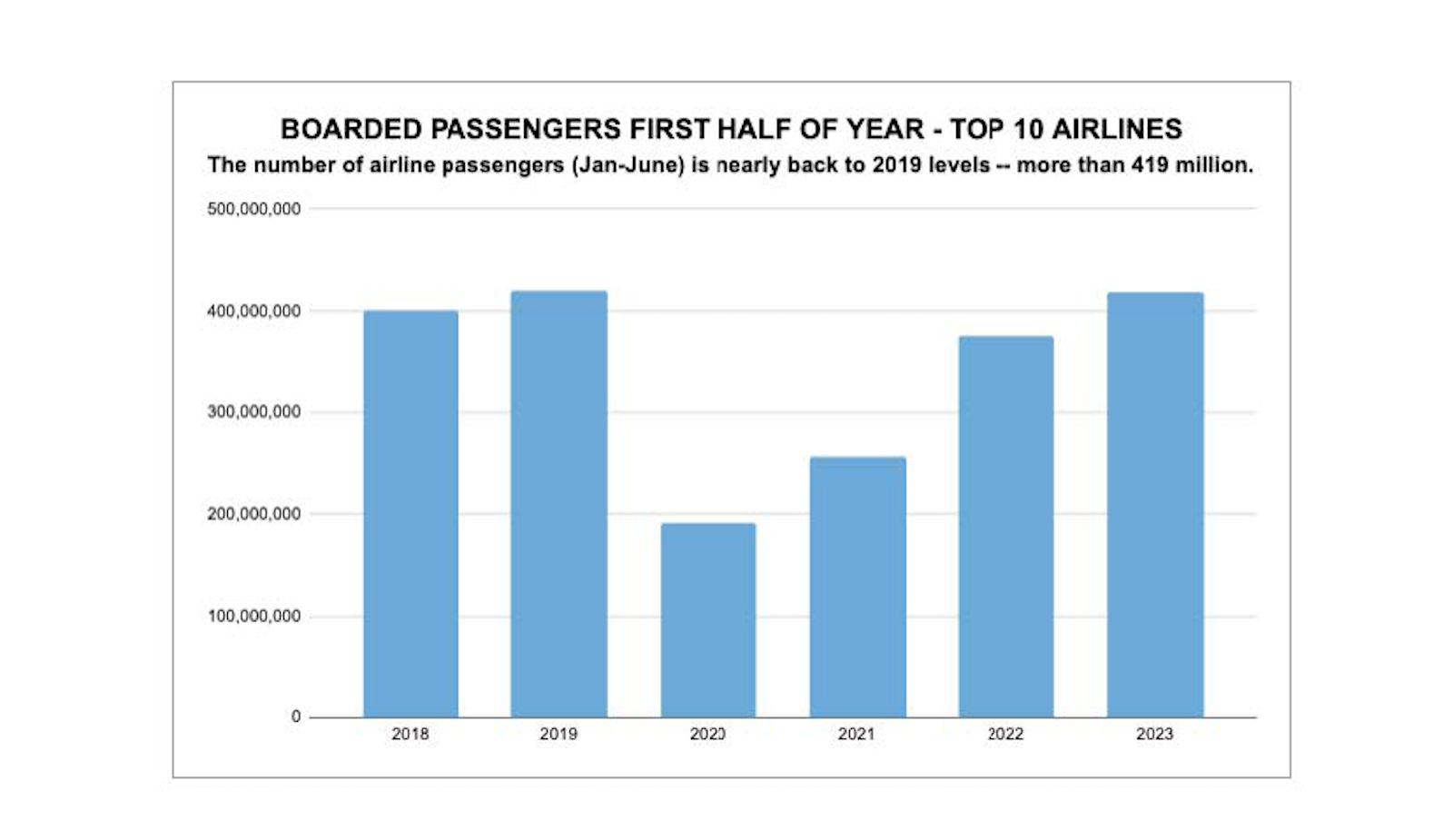
The Plane Truth Part 3
Complaint volume is larger than record-setting 2022, so high that DOT can't keep up.

VIEW THE FULL REPORT PDF
EXECUTIVE SUMMARY
So far in 2023, airline passengers aren’t finding travel much easier than it was in 2022. A little bit. But not much. At the same time, consumers are filing significantly more complaints this year than last.
Our analysis of newly released data from the U.S. Department of Transportation (DOT) shows airline performance has not noticeably improved compared with problem-filled 2022. DOT released operations data for the first half of 2023 on Sept. 27.
There are some encouraging signs as we enter into our fourth post-COVID holiday travel season. However, the most recently released information includes only one month of the summer travel season – June. And those results were mixed.
Here are the key takeaways from the analysis by U.S. PIRG Education Fund of the 10 largest airlines and their marketing carriers: (American, Alaska, Delta, Hawaiian and United this year marketed flights operated by their branded codeshare partners, such as Republic and SkyWest.)
- The number of airline passengers for the first half of 2023 increased by 11%, to 419.2 million. That’s the highest number since 2019 and puts us nearly back at pre-pandemic levels. There were 419.7 million passengers for the first half of 2019.
- Flights are fuller this year than they were in 2019. We had 419 million-plus passengers in both the first half of 2023 and the first half of 2019. But we’ve had fewer flights in 2023 – nearly 3.5 million this year compared with nearly 3.9 million in 2019, meaning the same number of people stuffed onto fewer flights.
- On-time performance in June fell to 71.3%, worse than a year ago. The on-time rate for the first half of 2023, at 76.5%, was a hair better than in 2022 but worse than in 2019.
- Cancellations in June fell to 2.1%, better than a year ago. The cancellation rate for the first half of 2023, at 1.6%, was half of what it was in 2022 and better than in 2019.
- The mishandled/lost baggage rate in June was flat compared with a year ago. And the mishandled baggage rate for the first half of 2023 was also flat compared with last year and 2019.
- The mishandled/damaged rate for wheelchairs and scooters in June was flat compared with a year ago. The mishandled rate for the first half of 2023 was slightly better than in 2022 and 2019.
- The percentage of passengers bumped involuntarily from overbooked flights during the second quarter was flat compared with a year ago. For the first half of 2023, the bump rate was slightly lower than in 2022 and flat compared with 2019.
- In June, airlines had 74 delays on the tarmac that exceeded three hours on domestic flights. In June 2022, there were 60 such tarmac delays. Airlines aren’t supposed to have tarmac delays exceeding three hours for domestic flights without giving passengers the opportunity to get off, unless there’s a safety, security or air traffic control issue.

COMPLAINTS ARE OVERWHELMING
Meanwhile, a year after consumer complaints against U.S. airlines hit a new record high, complaint volume is so large this year that DOT staffers have not been able to keep up with them. In fact, DOT hasn’t released any complaint totals beyond the February data.
After saying DOT would get caught up with complaint reporting this summer, officials in July said that isn’t happening after all. Now they are considering a new way to process the flood of complaints because there’s no slowdown in sight.
“I don’t think they’re ever going to go back to pre-pandemic numbers,” a DOT official told U.S PIRG Education Fund.
It’s troubling that complaints filed with DOT this year are exceeding the volume from the last two years by such a wide margin. Consumers can file complaints about U.S. and foreign airlines, ticket websites, etc. Complaints in 2021 hit nearly 50,000, the second-highest level ever, behind only 2020. Then last year, complaints increased by more than 50%, to nearly 78,000. The 2022 total was five times more than filed in 2019, the last normal pre-pandemic year, even though there were fewer passengers in 2022. When the totals are finally released for 2023, we wonder how high they’ll be.
Keep in mind, and this is important: Complaints are generally filed only after an airline hasn’t resolved a problem raised by a customer. So even one complaint about an airline not providing a legally required refund or paying to repair a damaged wheelchair is one complaint too many.
Most of the complaints during the last few years stemmed from flights that were extremely late or canceled, refunds not provided for canceled flights (which are required by law) and lost or damaged baggage.
DOT says that while officials are behind in categorizing complaints and tallying them by airline, they are still forwarding all complaints to whoever is named in it. Airlines are then required to acknowledge complaints filed with the DOT within 30 days and respond in writing within 60 days. Ticket agents are also expected to respond to consumer complaints, although there’s no timeline for replies.
WHAT HAPPENED DURING A BUSY JUNE?
To have a better idea of what might lie ahead during the holiday travel period, you might look at the record-setting volume of travel this summer. But overall statistics are available only through June. And when the passenger counts went up in June, performance got worse:
In June, with the 10 largest carriers and their partners:
- 71.3% of flights arrived on time (less than 15 minutes late,) worse than May’s 81.2%.
- 2.1% of domestic flights were canceled, worse than May’s 0.6%.
- 0.70% of bags were mishandled, worse than May’s 0.51%.
- Of the 77,661 wheelchairs and scooters that were checked, 1,126 or 1.45% were mishandled, worse than May’s 1.27%.
- There were 74 delays on the tarmac that exceeded three hours on domestic flights, up from three such tarmac delays in May.
On the on-time arrivals, it may not matter much if a flight arrives late by less than 15 minutes, but more than 25% of flights arrived late this summer, by an average of 57 minutes, according to information from FlightAware. A delay of nearly an hour can and often does make the difference between catching or missing a connecting flight. That can have a whole domino effect on various airlines and travelers for whom missing a flight could mean they miss a wedding, a cruise or other important event.

BEST AND WORST AIRLINES
On-time arrivals:
DOT considers flights on time if they arrive within 15 minutes of the scheduled time, meaning they weren’t delayed or canceled. In June, one in four flights was nearly an hour late, on average. The largest airlines’ on-time performance was 76.5% for the first half of 2023. Will it improve during the second half? Until last year, it finished below 77% for the entire year only once in the last 15 years.
The June average for the 10 largest carriers and their partners was 71.3%.
The three best in June:
- Alaska Airlines Network – 79.4%
- Delta Air Lines Network – 77.8%
- Hawaiian Airlines – 77.4%
The three worst in June:
- Frontier Airlines – 53.7%
- Spirit Airlines – 58.8%
- JetBlue Airways – 60.8%
For January through June 2023, the average on-time arrival rate was 76.5%. The ranking for the top 10 and their partners for the January through June 2023 period, best to worst:
- Delta – 81.5%
- Alaska – 79.5%
- American – 77.4%
- Southwest – 76%
- United – 75.6%
- Allegiant – 71.7%
- Jetblue – 68.6%
- Hawaiian – 67.4%
- Spirit – 66.8%
- Frontier – 63.6%
Cancellations:
The June average for the 10 largest carriers and their partners was 2.1% cancellations of scheduled domestic flights.
However, the rate of cancellations means only so much. The figures that DOT provides include only flights canceled within seven days before the planned departure date. Flights that get scrubbed more than seven days ahead of time are considered “discontinued flights.” A flight that gets canned eight or 10 days before your trip might be a hassle to rebook, and could mean you face higher prices or no available seats. But, shockingly, it doesn’t count against the airline.
This little-known fact about “discontinued” flights had been kept largely under wraps until cancellations started becoming such an enormous problem last year.
The three lowest cancellation rates in June, compared with the 2.1% average:
- Alaska – 0.3%
- Allegiant – 0.6%
- Southwest – 0.6%
The three worst cancellation rates in June, compared with the 2.1% average:
- United – 4.5%
- Frontier – 3.9%
- JetBlue – 3.5%
The cancellation rate for the first half of 2023 was 1.6%. The ranking for the top 10 and their partners for the January through June 2023 period, best to worst:
- Allegiant – 0.81%
- Alaska – 1.05%
- Southwest – 1.32%
- Hawaiian – 1.36%
- American – 1.44%
- Delta – 1.45%
- Jetblue – 1.86%
- United – 2.09%
- Frontier – 2.16%
- Spirit – 2.17%
Mishandled bags:
The mishandled bag rate for the first half of 2023 was 0.61 of 100 checked bags. This calculation included only checked bags on domestic, nonstop flights, meaning no connecting flight. The ranking for the top 10 and their partners, best to worst:
- Allegiant – 0.16
- Southwest – 0.46
- Frontier – 0.48
- Hawaiian – 0.5
- Delta – 0.51
- Jetblue – 0.54
- Alaska – 0.56
- Spirit – 0.58
- American – 0.81
- United – 0.82
Mishandled wheelchairs:
The percentage of mishandled/damaged wheelchairs and scooters for the first half of 2023 was 1.37%. The ranking of the top 10, best to worst:
- Allegiant – 0.06%
- Delta – 0.62%
- United – 1.25%
- Southwest – 1.61%
- Hawaiian – 1.62%
- Jetblue – 1.71%
- American – 1.78%
- Frontier – 1.79%
- Alaska – 1.96%
- Spirit – 5.89%
Getting bumped from flights:
Airlines generally overbook flights so they can maximize the number of passengers and therefore, maximize revenues. They’re pretty good, based on history and algorithms, at calculating how many passengers won’t show up at the gate for a particular flight for whatever reason. When the airlines miscalculate and too many passengers show up, airlines generally first ask for volunteers and may offer another flight as well as compensation for the inconvenience. When they don’t get enough volunteers, airlines have to bump people who didn’t volunteer.
For the first half of 2023, the rate of involuntary bumping was 0.33 per 10,000. The rates for the top 10 airlines and their partners, best to worst:
- Neither Allegiant nor Hawaiian had any involuntary bumps.
- See above
- Delta – 3 bumps, for a rate of 0 per 10,000.
- United – 184 bumps, for a rate of 0.03.
- Jetblue – 114 bumps, for a rate of 0.06.
- Alaska – 178 bumps, for a rate of 0.09.
- Southwest – 1,652 bumps, for a rate of 0.2.
- Spirit – 798 bumps, for a rate of 0.39.
- American – 5,033 bumps, for a rate of 0.54.
- Frontier – 5,782 bumps, for a rate of 4.19.
CONCLUSION AND RECOMMENDATIONS
It’s clear that three years after the pandemic hit and Congress gave the airlines $54 billion to keep them afloat, air travel still hasn’t bounced back. Some of that is their fault; some of it isn’t.
- Airlines should focus on realistic scheduling, fast refunds for canceled flights, up-front, transparent pricing instead of add-on gotcha fees, and quick resolution of problems so consumers don’t need to file a complaint.
- DOT should focus more on accountability from the airlines, particularly regarding scheduling, excessive cancellations and delays, slow-rolled refunds and disproportionately high complaint volume. Last year, Frontier Airlines had the largest number of complaints per 100,000 boarded passengers, followed by Spirit Airlines and JetBlue.Earlier this year, the DOT said it launched “a rigorous and comprehensive investigation” into possible “unrealistic scheduling” by four airlines, including Southwest, which had a meltdown over the Christmas holidays last year. Unrealistic scheduling is regarded as “an unfair and deceptive practice” under federal law, DOT said. We haven’t learned about any findings or actions. It’s irresponsible and harmful if airlines sell tickets to flights in bad faith, because last-minute cancellations can wreak havoc on travelers’ lives and wallets.
- On that note, DOT should revise its definition of a canceled flight to include more than just those canceled within seven days of the departure date. Right now, those are considered “discontinued flights” and DOT doesn’t even tally them nor are airlines accountable for them, despite the disruption they can cause.
- In its enforcement action in November 2022 against six airlines for taking too long to issue $600 million in refunds, DOT said the $7.25 million in civil penalties wouldn’t be the last ones if the airlines don’t do better and issue timely refunds as legally required. The enforcement included only one U.S. airline, Frontier. Slow issuance of refunds is still a problem. We haven’t seen any additional enforcement. DOT needs to keep its word and hold airlines accountable.
- DOT should also demand more accountability from third-party online ticket sellers, who make up a growing percentage of the market but often are a nightmare to deal with if a customer wants a refund for a canceled flight or needs to rebook a canceled or delayed flight.
- And DOT should do everything it can to make sure the skies have an adequate number of air traffic controllers. Airlines blame some issues on shortages here.
- Pilot shortages are also blamed for some of the cancellation/delay issues. All parties should work together to address this.
- Congress should allow state attorneys general to enforce federal consumer protection laws involving the airlines. The states want to and should be able to do this, but they can’t. Airlines are just about the only industry that is protected from state enforcement of consumer protection laws. And 35 of the state attorneys general signed a letter to Congress on this issue in August 2022.
- The DOT has done a great job of pushing the major carriers to adopt new passenger-friendly policies, such as family seating so young children can sit next to an adult companion at no additional charge. Other policies deal with the airlines’ commitments in cases of cancellations and delays under the airlines’ control. The DOT’s flightrights.gov dashboard clearly displays each airline’s policy on various issues. Further, once the airlines have made a promise like this to the DOT, it becomes part of their contract and they can’t go back on it.The hope is the transparency pushes more airlines to adopt such practices.

Travelers need more protections when flights are canceled
The Department of Transportation (DOT) needs to do more to put a stop to bad airline behavior.
Topics
Authors
Teresa Murray
Consumer Watchdog, U.S. PIRG Education Fund
Teresa directs the Consumer Watchdog office, which looks out for consumers’ health, safety and financial security. Previously, she worked as a journalist covering consumer issues and personal finance for two decades for Ohio’s largest daily newspaper. She received dozens of state and national journalism awards, including Best Columnist in Ohio, a National Headliner Award for coverage of the 2008-09 financial crisis, and a journalism public service award for exposing improper billing practices by Verizon that affected 15 million customers nationwide. Teresa and her husband live in Greater Cleveland and have two sons. She enjoys biking, house projects and music, and serves on her church missions team and stewardship board.
Find Out More

5 steps you can take to protect your privacy now

Trouble in Toyland 2023

VR risks for kids and teens
